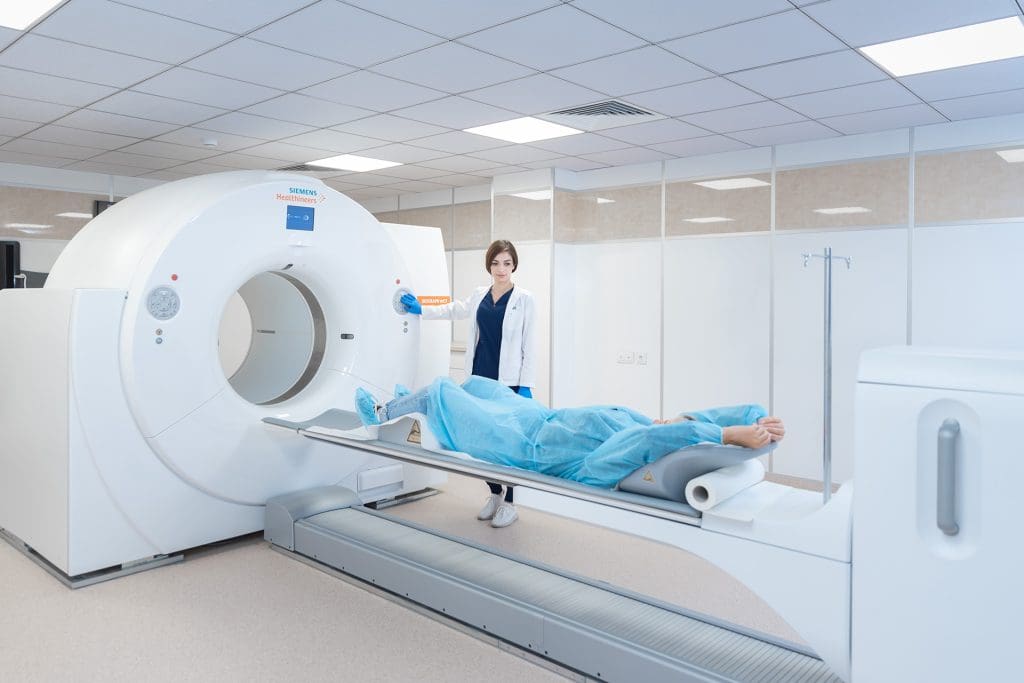Last Updated on November 27, 2025 by Bilal Hasdemir
Prostate cancer is a common disease in men around the world. It has a big impact on health. A key tool in finding and managing this cancer is the PET scan. This is thanks to new tracers like those in PSMA PET scans.
A PET scan for prostate cancer is a test that finds cancer cells. It uses a tiny amount of radioactive tracer. This tracer shows where cancer is in the body. This technology has changed how we diagnose prostate cancer, giving us a clearer picture of the disease.
Key Takeaways
- PET scans are increasingly important in prostate cancer diagnosis.
- The technology helps in identifying cancerous cells with high precision.
- Advanced tracers like PSMA are making PET scans more effective.
- Early detection through PET scans can greatly improve treatment results.
- PET scans are becoming more common in cancer care.
Understanding Prostate Cancer and Diagnostic Imaging

Prostate cancer is a big health problem. Accurate diagnostic imaging is key. It’s one of the most common cancers in men, affecting many lives.
The Prevalence and Impact of Prostate Cancer
Millions of men worldwide get prostate cancer every year. It greatly affects their quality of life. Early detection and accurate diagnosis are vital.
Key statistics on prostate cancer include:
- Prostate cancer is the second leading cause of cancer-related deaths among men in the United States.
- The American Cancer Society estimates that over 200,000 new cases of prostate cancer are diagnosed each year in the U.S.
- Early-stage prostate cancer often presents with no symptoms, highlighting the need for effective screening methods.
Evolution of Diagnostic Imaging for Prostate Cancer
Diagnostic imaging for prostate cancer has seen big improvements. Old methods like CT scans and bone scans are now joined by newer ones.
PSMA PET scans have changed the game. They are more sensitive and specific than older methods.
The Need for Advanced Imaging Techniques
Old imaging methods have their limits. This is why PSMA PET imaging is needed. It helps in accurately staging and restaging prostate cancer, which is key for treatment plans.
- Advanced imaging techniques help in identifying the extent of cancer spread.
- They enable clinicians to monitor treatment response more effectively.
- PSMA PET scans can detect recurrence at lower PSA levels than conventional imaging.
As oncology keeps evolving, advanced diagnostic imaging’s role in prostate cancer management grows more important.
The PSMA PET Scan: A Revolutionary Diagnostic Tool
The PSMA PET scan is a major leap in finding prostate cancer. It gives doctors a clear view of how far the cancer has spread. This helps in diagnosing and treating the disease more accurately.
Definition and Basic Principles
A PSMA PET scan uses a PET scanner to find prostate cancer cells. PSMA is a protein found on prostate cancer cells. The scan uses a radioactive tracer that sticks to PSMA, then uses PET imaging to show where the cancer is.
How PSMA PET Scans Differ from Conventional Imaging
PSMA PET scans are better at finding prostate cancer than CT scans or MRI. Conventional imaging looks for changes in the body, but these can be hard to spot in early cancer. PSMA PET scans, on the other hand, find cancer cells by looking for PSMA, even if the cancer is tiny or has spread far.
The main differences are:
- They can spot small tumors and metastases better
- They are more specific to prostate cancer cells
- They can find cancer even when PSA levels are very low
Types of Radiotracers Used in PSMA Imaging
There are several radiotracers for PSMA PET imaging, each with its own benefits. The most used ones are:
- Ga-68 PSMA-11: A gallium-68 labeled tracer known for its strong bond with PSMA and short half-life.
- F-18 PSMA-1007: A fluorine-18 labeled tracer with a longer half-life and better image quality.
These tracers are very accurate in finding prostate cancer. They are becoming more common in medical use.
The choice of radiotracer depends on several things, like what’s available and the patient’s situation. As research goes on, new tracers are being made to make PSMA PET scans even better.
How PSMA PET Scans Work
PSMA PET scans are key in finding and treating prostate cancer. They use special targeting and advanced imaging.
The Science Behind PSMA Targeting
PSMA PET scans find prostate cancer by looking for a protein called PSMA. PSMA is found on most prostate cancer cells. This makes it a great target for scans.
The scan uses a special dye that sticks to PSMA. This dye lights up cancer cells, showing where they are.
The Role of Radioactive Tracers
Radioactive tracers are essential for PSMA PET scans. They stick to PSMA on cancer cells. 68Ga-PSMA-11 is a common tracer that works well.
After being injected, the tracer goes to areas with lots of PSMA. The PET scanner picks up the radiation, making detailed images of cancer.
Image Acquisition and Processing
Getting images for PSMA PET scans involves a few steps. First, the tracer is given to the patient. Then, they go into the PET scanner.
The scanner catches the gamma rays from the tracer. This info is used to make detailed images.
Next, the images are improved for better quality. This includes fixing issues like scatter and making images from different angles. This gives a full view of the cancer.
Reading PSMA PET scans right needs special knowledge. It’s important for pet scan accuracy in finding and tracking cancer.
Indications for PSMA PET Scans
PSMA PET scanning is changing how we manage prostate cancer. It’s a key tool for diagnosing prostate cancer at different stages.
Initial Staging of Prostate Cancer
PSMA PET scans are vital for the first step in treating prostate cancer. They show how far the cancer has spread. This is important for choosing the right treatment.
Studies show PSMA PET scans are better at finding cancer spread than other methods. Accurate staging helps doctors pick the best treatment for each patient.
Biochemical Recurrence Detection
When prostate cancer comes back after treatment, PSMA PET scans can find it early. This is important when PSA levels go up after treatment.
Early detection means doctors can act fast. PSMA PET scans help find where and how much cancer has come back. This guides further treatment.
Treatment Planning and Monitoring
PSMA PET scans also help plan and check on treatments. They see how well treatments like targeted therapy or chemotherapy work.
By monitoring treatment response, doctors can make changes to care plans. PSMA PET scans give important info on treatment success. This helps make better decisions.
PSMA PET scans are a big step forward in prostate cancer care. As research grows, their role will likely get even bigger. This will help diagnose and treat prostate cancer better.
Preparing for a PSMA PET Scan
Getting ready for a PSMA PET scan is key for prostate cancer patients. It helps get accurate results. Proper prep can avoid delays and ensure reliable results.
Pre-scan Instructions
Before the scan, patients get specific directions from their doctor or the imaging center. These might include:
- Arriving at least 30 minutes early to fill out paperwork and get ready.
- Telling about current meds and allergies.
- Removing metal items like jewelry or glasses to avoid scan interference.
Dietary and Medication Considerations
What you eat and take before the scan matters. Patients might be told to:
- Stick to a certain diet or fast before the scan.
- Not take certain meds or supplements that could mess up the scan.
It’s vital to follow these steps to get accurate scan results.
What to Expect on the Day of the Scan
On scan day, here’s what happens:
- A radiotracer is injected into a vein in your arm.
- You’ll wait 60-90 minutes for the tracer to spread in your body.
- The scan itself takes about 30-60 minutes.
You’ll need to stay very quiet and might be asked to hold your breath briefly.
Knowing what to expect and following pre-scan advice helps ensure a good PSMA PET scan. This leads to accurate results.
The PSMA PET Scan Procedure Step by Step
To understand what to expect during a PSMA PET scan, it’s essential to break down the procedure into its constituent parts. The process involves several key steps, from the initial preparation to the final scanning.
Radiotracer Injection Process
The first step in the PSMA PET scan procedure is the injection of a radiotracer. This is typically done intravenously. The radiotracer used is designed to target the Prostate-Specific Membrane Antigen (PSMA) on prostate cancer cells. The injection process is usually quick and may cause minimal discomfort.
The Scanning Process
After the radiotracer has been allowed to circulate and bind to the target areas, the scanning process begins. The patient is positioned on a scanning table, which then moves through a PET/CT scanner. This scanner captures detailed images of the body’s metabolic activity, highlighting areas where the radiotracer has accumulated.
The scanning process typically takes around 30 minutes to an hour, during which the patient must remain very quiet to ensure clear images.
Duration and Patient Experience
The entire PSMA PET scan procedure, from preparation to the completion of the scan, can take a few hours. Patients are advised to plan ahead and stay hydrated during this time. While the scanning process itself is painless, some patients may experience mild side effects from the radiotracer, such as nausea or dizziness.
Overall, the PSMA PET scan is a valuable diagnostic tool that provides critical information for the management of prostate cancer. Its accuracy and specificity make it an essential component of modern prostate cancer care.
Key aspects of the PSMA PET scan procedure include:
- Radiotracer injection
- Scanning process
- Duration of the procedure
- Patient experience during the scan
By understanding these elements, patients can better prepare themselves for the procedure and know what to expect.
Interpreting PSMA PET Scan Results
Understanding PSMA PET scan results is key for prostate cancer treatment. It’s important to know how to read these results to help patients. This knowledge helps doctors decide the best treatment plan.
Understanding the Imaging Reports
PSMA PET scan results come in a detailed report. This report shows where and how much of the radiotracer is taken up in the body. It’s vital to understand these reports to see how far prostate cancer has spread.
The reports talk about the primary tumor, lymph node involvement, and distant metastases. Knowing this helps doctors stage the cancer right. It also helps plan the best treatment.
Common Findings and Their Significance
PSMA PET scans often show increased radiotracer uptake in the prostate, lymph nodes, or bones. Increased uptake in the prostate gland might mean a primary tumor. Uptake in lymph nodes or bones could mean the cancer has spread.
These findings help doctors decide on treatments like surgery, radiation, or hormone therapy. Accurate results help tailor treatments to each patient’s needs.
Timeframe for Receiving Results
How long it takes to get PSMA PET scan results varies. It usually takes a few days to a week.
It’s important for patients to talk to their doctors about the results. This helps understand what the findings mean and what to do next.
Accuracy and Limitations of PSMA PET Scans
PSMA PET scans are becoming key in diagnosing and planning treatment for prostate cancer. They are very sensitive and specific. Yet, like all medical tools, they have their limits.
Sensitivity and Specificity Rates
Research shows PSMA PET scans are very good at finding prostate cancer, even when it comes back. Sensitivity rates range from 80% to over 90%, depending on the tracer and patients. Their specificity is also high, but can be affected by benign conditions.
A meta-analysis found a pooled sensitivity of 86% and specificity of 95% for prostate cancer detection. This shows PSMA PET scans can accurately spot cancer, even when other scans can’t.
Potential False Positives and Negatives
Even though PSMA PET scans are accurate, they can sometimes give false results. False positives can happen due to benign conditions like fractures or inflammation. False negatives might occur if the cancer doesn’t express PSMA or is very small.
- Benign conditions that may cause false positives include:
- Fractures or bone injuries
- Inflammatory processes
- Benign prostatic hyperplasia
- Factors contributing to false negatives:
- Low PSMA expression by the tumor
- Small tumor size
- Technical factors related to image acquisition
Comparison with Other Imaging Modalities
PSMA PET scans are often better than other imaging methods for prostate cancer. They have higher sensitivity and specificity than CT scans and bone scans, which are good for finding metastases.
A study showed PSMA PET scans found more lesions than other imaging in patients with recurrence. This led to changes in treatment plans for many patients. The choice of imaging depends on the patient’s situation and other factors.
In summary, PSMA PET scans are very accurate for prostate cancer imaging. But, it’s important to know their limitations. This knowledge helps doctors make better decisions for diagnosis and treatment.
Comparing PSMA PET Scans with Other Prostate Cancer Imaging Techniques
There are many ways to image prostate cancer, like PSMA PET, bone scans, and MRI. Knowing what each can do is key for the best care.
PSMA PET vs. Conventional Bone Scans
Bone scans have been used for years to find cancer in bones. But, PSMA PET scans are better at finding small bone metastases. They also spot cancer in other places, not just bones.
A study showed PSMA PET scans find more cancer spots than bone scans. This is very important for catching cancer early in patients with biochemical recurrence.
PSMA PET vs. MRI for Prostate Cancer
MRI is great for seeing how close cancer is to other parts of the body. It helps plan treatments. But, PSMA PET scans can see cancer spreading to other parts of the body.
Choosing between MRI and PSMA PET depends on what you want to know. MRI is best for looking at the local area. PSMA PET is better for seeing if cancer has spread.
When Different Imaging Modalities Are Recommended
Guidelines suggest different scans based on the patient’s situation. For example, PSMA PET scans are great for catching cancer that has come back or for high-risk patients.
- Conventional bone scans are suggested for initial staging in some cases, like low-risk patients or when PSMA PET is not available.
- MRI is recommended for looking at the prostate and how far cancer has spread.
- PSMA PET scans are increasingly utilized for initial staging in high-risk patients and for detecting recurrent cancer.
The right scan for a patient depends on their specific needs. It’s all about using the best tool for the job.
Safety Considerations and Possible Risks
PSMA PET scans are becoming more common in prostate cancer care. It’s important for patients and doctors to know about their safety. These scans help diagnose and manage prostate cancer, but there are risks to consider.
Radiation Exposure Concerns
One major concern is radiation exposure from PSMA PET scans. The scan uses a small amount of radioactive tracer. This radiation is low, similar to other scans like CT scans.
But, the total radiation over time is something to think about. This is true for patients who need many scans or have had other radiation tests. Doctors consider this when deciding if and how often to use PSMA PET scans.
Possible Side Effects and Complications
PSMA PET scans are usually safe, but they can cause some side effects. Common issues include mild reactions at the injection site and sometimes allergic reactions to the tracer.
Though rare, serious problems can happen. It’s important for patients to tell their doctors about any health issues before the scan. For example, kidney disease can increase the risk of complications.
Contraindications for PSMA PET Scanning
Some situations make PSMA PET scans not safe. Pregnancy and breastfeeding are big no-go’s because of radiation risks to the baby. Women who are pregnant or breastfeeding should talk to their doctor about other tests.
Severe kidney or liver disease also needs careful thought. These conditions can affect how the tracer is cleared from the body. And, if you’re allergic to the tracer, you should avoid the scan.
Knowing about these safety points is key to using PSMA PET scans safely in prostate cancer care.
Cost and Insurance Coverage for PSMA PET Scans
PSMA PET scans are a big deal for those looking for top-notch diagnostic care. The cost can be high, and figuring out insurance and financial help is key.
Average Costs in the United States
In the U.S., PSMA PET scan prices vary. This depends on where you get the scan, the radiotracer used, and if extra tests are done. On average, you might pay between $5,000 and $15,000 or more.
What affects the price includes:
- The type of radiotracer used for the PSMA PET scan
- Facility fees for the scanning procedure
- Professional fees for interpreting the scan results
- Additional costs for any supplementary procedures or tests
Insurance Coverage and FDA Approval Status
Insurance for PSMA PET scans has changed with FDA approval of certain radiotracers. Now, many private insurers cover these scans for prostate cancer. This is for diagnosis and management.
It’s vital to check your insurance, as policies differ a lot. Coverage depends on:
- The reason for the scan (e.g., initial staging, biochemical recurrence)
- Your insurance plan and its rules
- The FDA approval of the radiotracer
Financial Assistance Options
If PSMA PET scans are too expensive, there are ways to get help. You might find:
- Patient assistance programs from drug makers
- Financial aid from non-profit groups for cancer patients
- Government programs for those who qualify
Talk to your doctor or a financial advisor to see what help is out there.
Finding PSMA PET Scan Facilities Near You
PSMA PET scans are key in prostate cancer care. Patients are looking for where to get these scans. As more places offer them, knowing how to find a good facility is important.
Availability Across the United States
PSMA PET scan facilities are spreading across the U.S. Big cancer centers and community hospitals now offer them. To find one near you:
- Ask your doctor or oncologist for advice.
- Look up major cancer centers or hospitals online.
- Use online directories for PET scan places.
Even though they’re getting more common, some areas might not have them yet.
Questions to Ask When Choosing a Facility
When picking a PSMA PET scan place, think about these things:
- Experience and Accreditation: Make sure they’re good at PSMA PET scans and are certified.
- Technology and Equipment: Find out what kind of PET/CT scanner they use and its quality.
- Radiotracer Availability: Check if they use the right PSMA-targeting radiotracer your doctor suggests.
- Reporting and Follow-up: Know how they report results and handle follow-up care.
Referral Process and Requirements
Usually, you need a doctor’s referral for a PSMA PET scan. The steps are:
- Talk to your oncologist or urologist to see if you need a scan.
- Get a referral or order for the scan.
- Call the facility you picked to book and learn what they need from you.
Knowing these steps helps patients find and use PSMA PET scans for better prostate cancer care.
Conclusion: The Future of PSMA PET Scanning in Prostate Cancer Care
The PSMA PET scan has changed how we diagnose and treat prostate cancer. It’s very good at finding where cancer has spread or come back. This makes it a key tool in prostate cancer care.
Looking ahead, PSMA PET scanning will likely get even better. New research and better radiotracers will make it even more useful. This could lead to better care for patients, making treatments more effective.
PSMA PET scans are becoming more important in fighting prostate cancer. Knowing how they work and their future can help doctors and patients make better choices. This knowledge is vital for improving prostate cancer care.
FAQ
Can PSMA PET scans be used for monitoring treatment response?
Yes, PSMA PET scans can track how well treatment is working. They help see if the therapy is effective and if changes are needed.
What is the significance of PSMA PET scan in treatment planning for prostate cancer?
PSMA PET scans are key in planning treatment. They give accurate info on how far the disease has spread. This helps decide on surgery, radiation, and other treatments.
How can I find a facility that offers PSMA PET scans near me?
To find a facility, ask your doctor for a referral or search online. Look at their experience, equipment, and patient reviews when choosing.
Are PSMA PET scans safe, and what are the possible risks?
PSMA PET scans are usually safe but involve some radiation. Side effects are rare and mild. Some people may not be able to have the scan due to certain conditions or allergies.
How do PSMA PET scans compare to other imaging modalities for prostate cancer?
PSMA PET scans are better than some other tests like bone scans and MRI in certain cases. The best test depends on your situation and what your doctor recommends.
What is the accuracy of PSMA PET scans in detecting prostate cancer?
PSMA PET scans are very good at finding prostate cancer, even when it has spread. But, like any test, there’s a chance of false positives and negatives.
How are PSMA PET scan results interpreted?
A radiologist will look at the images for areas of increased tracer uptake. This shows where prostate cancer cells are. Your doctor will discuss the results with you in a report.
What can I expect during the PSMA PET scan procedure?
During the procedure, a radioactive tracer is injected into a vein. You’ll wait for a bit before the scan. The scan takes 30-60 minutes. You’ll lie on a table that slides into a PET scanner.
How do I prepare for a PSMA PET scan?
To prepare for a PSMA PET scan, follow specific instructions. This includes dietary restrictions and adjusting medications. Plan to arrive early and wear comfortable clothes.
What are the benefits of using PSMA PET scans for prostate cancer diagnosis?
PSMA PET scans have many benefits. They are very accurate in finding prostate cancer, even when it has spread. They help in staging, finding cancer that has come back, and planning treatment.
What is a PSMA PET scan and how does it work?
A PSMA PET scan is a test that uses a radioactive tracer to find prostate cancer cells. It works by injecting a small amount of radioactive material. This material binds to the PSMA protein on prostate cancer cells, allowing for detailed images to be taken.





